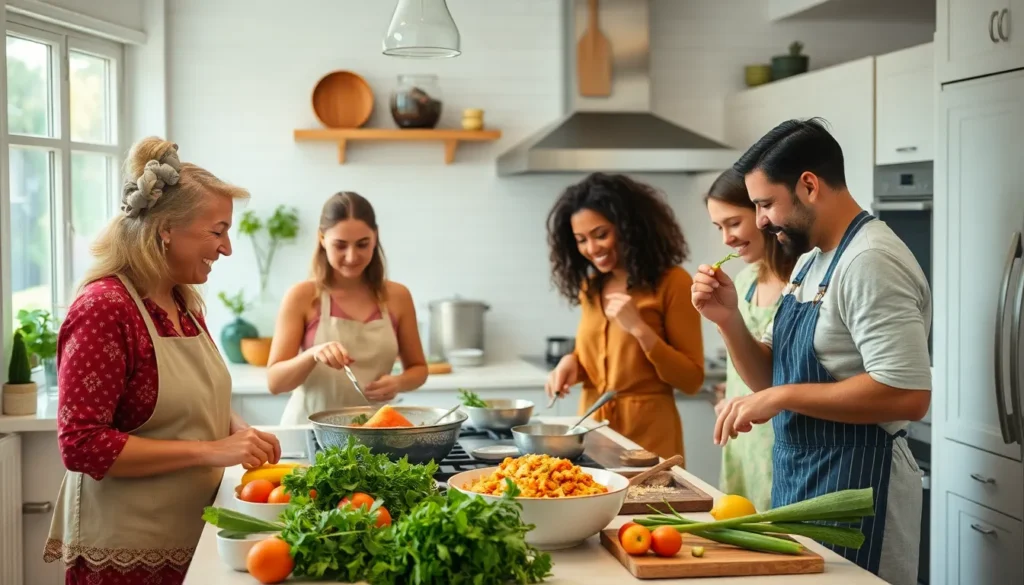Table of Contents
ToggleEvery home cook has experienced the moment of truth: that first bite of a new recipe. Sometimes it’s a culinary triumph, and other times, it’s a flavor fiasco that leaves taste buds in turmoil. But what if there was a way to transform those kitchen disasters into delectable delights? Recipe improvement is the secret sauce that can elevate any dish from “meh” to “wow” faster than you can say “season it!”
Understanding Recipe Improvement
Improving recipes enhances culinary outcomes. Many home cooks strive for better results and want to avoid disappointing dishes.
Importance of Recipe Improvement
Recipe improvement matters for several reasons. Enhancing flavors elevates meals, making them more enjoyable. Adjustments can accommodate dietary preferences, ensuring everyone can savor the dish. Skill development plays a role in nurturing cooking confidence, encouraging experimentation. Recipes can also reflect seasonal ingredients, promoting freshness and nutrition. Altogether, improved recipes lead to memorable dining experiences.
Common Challenges in Recipe Development
Numerous challenges arise during recipe development. Ingredient selection can prove difficult, especially when substitutions are necessary. Balancing flavors requires understanding of how various components interact. Time management impacts preparation, as skilled cooks often multitask effectively. Consistency is another issue; achieving the same delicious result each time needs practice and precision. Lastly, uncertainty about cooking methods may complicate the process. Addressing these challenges improves overall culinary skills and satisfaction.
Techniques for Effective Recipe Improvement

Improving a recipe requires thoughtful techniques and adjustments. Specific approaches can lead to enhanced flavors and overall satisfaction.
Ingredient Substitutions
Substituting ingredients can elevate a dish’s profile. For instance, using Greek yogurt instead of sour cream adds creaminess while cutting fat. Alternatives like quinoa instead of rice boost protein content. Fresh herbs, such as cilantro or basil, can replace dried varieties for richer flavor. When allergies or dietary restrictions arise, swap gluten-containing products with gluten-free options like almond flour. Experimenting with sweeteners, like honey instead of sugar, can also change a dish’s taste and health benefits. Each change provides a chance to customize and improve a recipe significantly.
Cooking Method Adjustments
Adjusting cooking methods can transform a dish entirely. Braising meat instead of grilling may enhance tenderness and flavor depth. Alternatively, roasting vegetables brings out natural sweetness through caramelization. Employing techniques like steaming can retain nutrients in greens compared to boiling. Switching from frying to baking decreases grease while maintaining texture. Cooking time adjustments, such as lowering heat for a longer duration, enhance flavors. When learning new techniques, home cooks gain confidence and skills, further refining their cooking style. Each method presents an opportunity for improvement, making dishes more appealing and memorable.
Testing and Feedback in Recipe Improvement
Testing and gathering feedback is crucial in the process of recipe improvement. Feedback from others can help refine flavors and enhance the dish’s overall appeal.
Gathering Feedback from Taste Testers
Taste testers provide valuable insights into a dish’s taste, texture, and presentation. He can recruit friends or family members who enjoy cooking or have a passion for food. Collaboration during these tasting sessions allows diverse opinions to surface. They may point out flavor imbalances or suggest adjustments that may not be apparent to the chef. Focusing on constructive criticism fosters a supportive atmosphere for culinary growth, making it easier to identify areas for improvement. Timing these sessions during a meal or gathering optimizes engagement and honest feedback.
Iterating Based on Feedback
Iterating on feedback received can significantly enhance a recipe’s quality. Start by analyzing the comments made by taste testers, noting common themes or suggestions. Adapting the recipe to include their recommendations, whether by adjusting seasoning or altering techniques, encourages experimentation. Consider testing variations, like modifying ingredient proportions or cooking times, to observe the impact on the final dish. Each iteration provides an opportunity to refine the recipe further, leading to improved outcomes. Documenting changes made ensures a clear progression of the recipe’s development, aiding future iterations and enhancing culinary skills.
Case Studies in Recipe Improvement
Home cooks frequently encounter the need for recipe improvement. This section presents real-world examples of successful transformations and valuable lessons learned from failures.
Successful Recipe Transformations
One notable example involved a basic pasta dish that initially lacked flavor. By adding roasted garlic and fresh basil, the dish transformed into a savory delight. Similarly, a bland chicken stir-fry evolved when cooks replaced soy sauce with a homemade marinade featuring ginger, sesame oil, and scallions. Each adjustment not only enhanced taste but also introduced new textures. Another successful transformation featured a standard chocolate cake that became extraordinary with the addition of espresso powder and a pinch of sea salt. These improvements showcase how simple changes can elevate everyday recipes, creating memorable meal experiences.
Lessons Learned from Failed Attempts
Failed attempts often serve as valuable learning experiences in the kitchen. One cook overcooked vegetables in a stir-fry, resulting in mushiness rather than crispness. The lesson highlighted the importance of timing when incorporating ingredients. Another cook attempted a new baking technique but ended up with a dense bread. Analyzing the process revealed that the oven temperature was too high, affecting the bread’s rise. Gathering feedback from taste testers also proved essential. They pointed out that while flavors were promising, the texture needed refinement. Such experiences underscore the significance of careful observation and willingness to adapt, guiding cooks toward more successful culinary ventures.
Recipe improvement is an essential journey for any home cook aiming to elevate their culinary creations. By embracing experimentation and thoughtful adjustments, they can transform everyday meals into extraordinary experiences. The process of gathering feedback and iterating on recipes not only enhances the final dish but also builds confidence and skill in the kitchen.
With a focus on seasonal ingredients and innovative cooking techniques, cooks can discover new flavors and textures that surprise and delight. Each attempt, whether successful or not, contributes to a deeper understanding of cooking, leading to more satisfying and memorable dining moments. Ultimately, recipe improvement is about exploration and growth, making every meal an opportunity for creativity and enjoyment.




